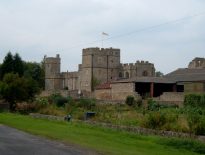
Snape Castle
It is said that Katherine was a kind stepmother to John and his sister, Margaret, evidenced by the latter's will dated 1545, which thanked Katherine for her education and the kindness and love she had received when younger. John, however, although treated kindly by Katherine, developed into a sulking, confidently sly child and this led to his father not naming John as his heir, but stating in his will that Katherine was to be in charge of the 4th Baron's affairs, which were to be given to his daughter when she reached majority. In January 1537, John's father, the 3rd Baron Latimer, somehow became embroiled in the Pilgrimage of Grace, and the rebels ransacked Snape Castle and held Katherine, Margaret and John hostage there. When the baron returned to the castle, he talked the rebels into leaving and releasing his family; however, he was severely implicated in the plot against the king and the family reputation suffered.
Following the 3rd Baron Latimer’s death in 1543, his son John inherited the title and became 4th Baron Latimer. In May 1544, John was involved in the Siege of Edinburgh, and he was knighted following this event. He then served with the king's forces in France, taking part in the Siege of Abbeville. John married Lucy Somerset, daughter of Henry Somerset, 2nd Earl of Worcester, in 1544, and Katherine, now Queen Consort, perhaps out of an old fondness for her stepson, named Lucy as one of her ladies in waiting.
It is said that John Neville was not a stable man, hinted at perhaps by his sly nature as a child. In 1553, he was sent to prison, charged with violence against a servant; in 1557, he was arrested for attempted rape and assault, and in 1563 he committed murder. In a letter to the Earl of Rutland, Thomas Edwards described John Neville's violence as too great a villainy for a nobleman. As all of these incidents of violence took place following Katherine Parr's death, it is believed that she may have had some form of control over John and his anger while she was alive.
John Neville, 4th Baron Latimer, died in 1577 without a male heir, and the title was wrongly assumed by Richard Neville of Penwyn, grandson of Richard Neville, 2nd Baron Latimer. However, modern sources say that the barony fell into abeyance among the baron's four daughters until 1913, when it was given to a descendent of the baron's fourth daughter, Lucy.
by Georgia Whitehead.
Georgia has just finished her masters in Classics at the University of Edinburgh. Academically, Georgia is interested in early Christianity, with her master's thesis focusing on "The Male Gaze and Self-Representation in Female Christian Narratives". In addition to her interest in ancient history, she has always been an avid lover of the Tudor era, drawn to the magnificence of the Tudor courts and the larger than life characters. She is particularly interested in The Reformation, Christianity and the shifting sands of ecclesiastical politics in this period and also has a keen interest in the lives of Tudor women. It is Georgia's ambition to become a writer, perhaps publishing her own Tudor novel one day.
Georgia also runs a history blog and instagram page called Historia Mundis.
Sources
- James, Susan E. (2009). Catherine Parr, Henry VIII's Last Love.
- Porter, Linda (2010). Katherine the Queen; The Remarkable Life of Katherine Parr, the Last Wife of Henry VIII.
Picture: © Copyright Russel Wills and licensed for reuse under this Creative Commons Licence. Gepgraph.org.uk.



Leave a Reply